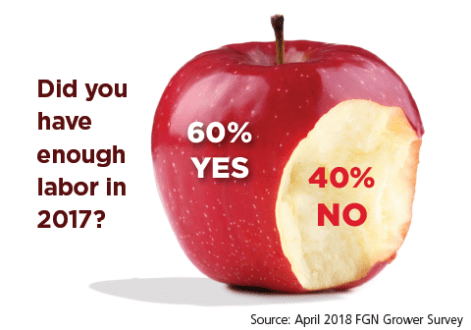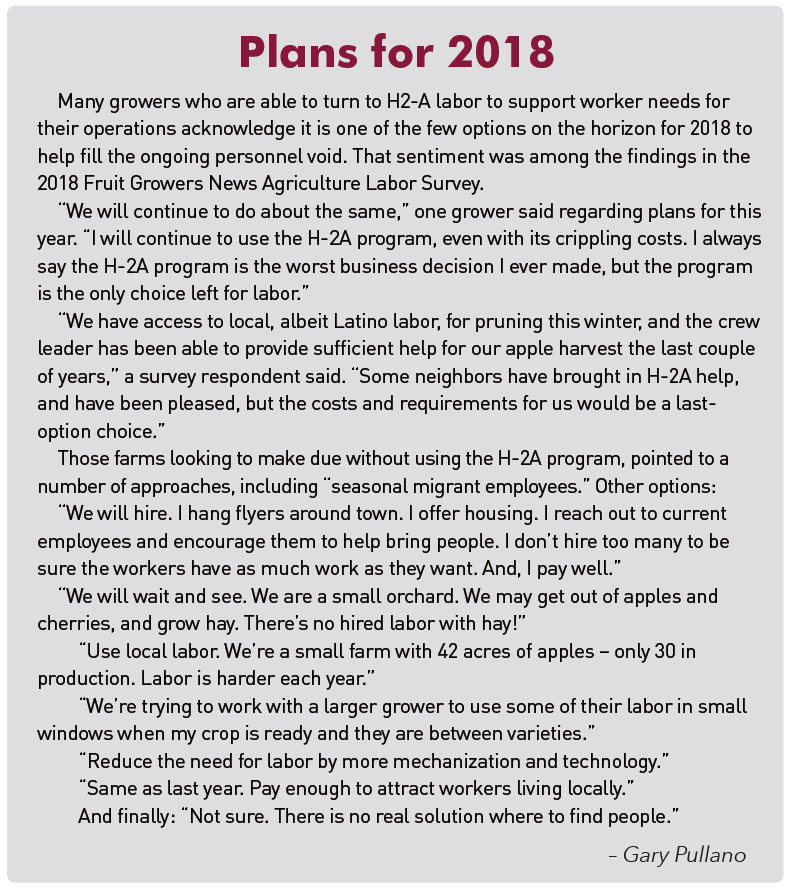

Jun 18, 2018Growers: Far too few workers
Conditions may be improving slightly for the fruit growing community, based on responses to a labor survey conducted by Fruit Growers News, but 40 percent of respondents still experienced severe worker shortages in 2017. Most continue to search for labor solutions to meet their crop production goals.
The survey – conducted in the first quarter of 2018 – asked growers if they had enough labor in 2017. Nearly 60 percent indicated they did have adequate worker numbers for the previous season. Growers reported better results in 2017 worker turnout, compared to more deficient worker totals in 2016.
Sixty percent of farm operators had enough labor in 2017, compared to 47 percent for 2016. The percentage of worker openings reached as high as 70 percent, with the majority showing deficiencies of less than 30 percent.
Farms that fell short of their required worker numbers in 2017 pursued a number of strategies to make up the difference, including working more with less.
“We worked longer hours, using mechanical harvest when able,” said one respondent.
Some other impacts included “harvesting only the prime fruit,” “worked harder, longer hours while hiring more teenagers and paying higher wages,” “sold equipment,” “disced the field,” “lost crop and sales,” “unable to make up the difference because the weather turned bad and fruit froze.”
Other operators had to take what was available: “two-thirds of the way through we had an influx of pickers and got the crop off in less than prime condition,” one grower said.
While some respondents said they just did “nothing,” some took drastic action, including: “found another source of income,” “sized down,” or “cut back on family spending.” One operator said they “sold out.”
At least one-third of the growers said they had to leave crops in their orchards or fields.
“Yes, we lost around $100,000 or more,” one operator indicated.
The majority of respondents were able to harvest at least a portion of their crop despite labor shortages, but ranges went from zero crops going unpicked to 100 percent loss in one case.
H-2A concerns
The cumbersome H-2A visa program is growing annually, but it is catching on slowly with operations that responded to the FGN questionnaire. Just 38 percent used the program in 2017, with 62 percent not pursuing that option.
While some operations just don’t see H-2A as being a good fit for them – some due to the size of the farm – a number of specific concerns were raised by those not using the program, including the following:
- “The added cost (including administrative) is prohibitive for as few people as I need. I can add that added cost to the wages I pay and poach employees of my neighbors.”
- “Not big enough to provide housing, etc.”
- “Compliance concerns, housing.”
- “Cost is prohibitive and and the process is not efficient. There are much more effective ways to bring agriculture labor in, but politicians have been kicking this can down the road for years.”
- “Costs prohibit using this labor. If I can’t do it by machine, it will not get done.”
- “The adverse wage is very high. It seems that unions set the price, which is 30 percent over minimum wage. We directly compete with Mexico where they pay their workers $11 a day. If we hope to have domestic food production, someone must recognize this fact.”
- “It takes too long to prepare, resulting in delays to attract timely numbers of people.”
- “We need year-round. Too much paper. Unreliable and slow. Terrible program.”
- “The associated costs would be prohibitive. It would be a last option, and possibly would force us into orchard removal.”
- “We farm in the Pugent Sound region. Housing is not affordable and we can’t build worker housing due to many regulations.”
- “The adverse wage is too high. It should be within 10 percent of the minimum wage. It shouldn’t require a foreman. This isn’t a union shop where people are needed to stand around and get paid for it.”
- “It provides labor, but it is extremely expensive in California.”
- “H2-A raised my labor rates 15-20 percent, which may not be sustainable.”
- One grower “had workers with a lot of experience in spraying coming from Belize for eight years. We found out in mid-January they could not come because Belize was banned from sending H-2A and H-2B workers – along with Haiti and Samoa this year. “
- “H-2A is the only way we can continue to farm fresh market fruit and vegetables. However, we won’t be able to afford the program much longer.”
- “H-2A is costly with petition costs and massive amounts of paperwork. But it’s the only legal option we have. Hopefully, a farmer-friendly version can be approved. The H-2C bill needs to be monitored closely.”
Wage rate average
Survey respondents indicated they pay farmworkers an average of approximately $12 an hour for harvesting their fruit crops.
A few of the growers using the H-2A program were impacted by their state’s Adverse Effect Wage Rates (AEWR), the rate participating farms must pay all workers – including their domestic help. This bumped several operations to $16 an hour or higher for 2017.
The lowest pay reported was $8 an hour.
Using piece rate also brings an adjustment to the wage averages.
“We pay $14.12 per hour,” one grower said. “If we do piece work, it depends on the workers’ speed. We average $16 per hour up to $20. With the adverse wage so high, some workers can’t work up to that $14.12 minimum wage.”
– Gary Pullano, FGN Managing Editor















